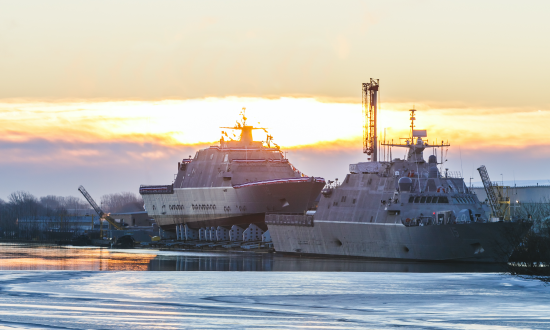There are some famous examples of naval design gone awry. The 17th-century Swedish flagship Vasa sank on her maiden voyage, before ever leaving Stockholm harbor. And entire fleets have been rendered obsolete by radical new technologies: Iron overnight replaced wooden ships in the 19th century; HMS Dreadnought in 1906 made all previous battleships obsolete. Ships can be too heavy or too light. Too slow. Not enough range. Not heavily enough armed or sporting the wrong weapons.
I know some of this from experience as a Royal Navy officer on a then-new missile frigate that incorporated a number of innovative features, including new materials in the construction. Unfortunately, this experimentation led to structural cracks in the hull and superstructure that prevented us from sailing on operations where rough seas were a constant, such as the nearby North Atlantic.
Typically, one thinks of these design flaws as rarities. But for the U.S. Navy’s surface vessels, the past two decades have been something of a design and production losing streak. Delays, cancellations, cost overruns, reduced capabilities, and underperformance have upended what the force will look like.
Planning fleet size and composition is like building a retirement portfolio. The individual investments are long-term bets. A poor decision now affects how you will live (or fight) 20 or 30 years from now. So what do you want in your portfolio? Stability, predictability, return on investment. Maybe a few gambles, but not with every penny you have.
Readers of Proceedings are familiar with the problems that have plagued individual classes of vessels over the past 20 years—the littoral combat ships, the Zumwalt class, the Gerald R. Ford (CVN-78). The first two America-class amphibious assault ships, built without a well deck. But rather than focus on individual ship classes, I suggest looking at the problem system-wide.
Unlike some historic examples, U.S. design woes are not the result of ships being superseded by new technologies. Quite the opposite: Current failures have occurred while trying to build on the lead the Navy already has. The failure of ship design and new technologies has “sunk” not one or two experimental vessels, but entire classes of warships. China is not sinking these ships; failed innovation is.
Publicly, the shortcomings are blamed on a number of causes: untested, “immature” technologies; lack of a clearly defined purpose; a shrinking industrial base; procurement “innovations.” Ironically, experiments with contract cost caps have led to vast cost overruns.
In some cases, the operational viability of ships and classes has remained unproven for years, to be “resolved” only by lowering expectations or requirements. There are similarities here to the reported failures of the Boeing 737 MAX and its MCAS software: changes to the scope or requirements of the new technology, what it was intended to do; limited testing and scrutiny; a lack of systems redundancy for the new kit; a rush to get platforms into service to match rivals and competitors.
Taken together, gaffes in ship design have effects that will stretch over decades. When industry has a product failure—New Coke, Google Glass—there are backups. Elon Musk can “embrace the failure” of Tesla Cybertruck windows. The Navy does not have that luxury. Fleet strength is dependent on a few big, expensive bets.
The Navy hopes to grow to 355 ships, but it is difficult to make the numbers add up when class sizes are drastically cut and relatively new ships are retired early. The 355-ship target has been a bipartisan objective since 2016, and the Biden administration has said shipbuilding will be a focus of its defense plans. This stability should be reassuring, but the Navy is all too aware that failures in design mean it has to work more frantically to achieve the 355 prize.
Also being eliminated: new technologies and functions. The Gerald R. Ford–class carriers debut 5 new technologies, the Zumwalt guided-missile destroyers 12, of which 3 were removed as requirements. By comparison, neither Dreadnought’s fundamental new design nor her technologies failed or needed to be removed; rather she served as a proving ground on which they could be improved in subsequent classes. And she was built and commissioned in one year.
Since 9/11, America’s wars have been largely land affairs, but the next one may very well be maritime. Conflict with China, Iran, or North Korea almost certainly would see major sea lanes contested. Coupled with this, other navies have been ramping up their capabilities: More countries have capable aircraft carriers, antiship-capable submarines, hypersonic missiles. The other great powers are becoming more competitive.
The balance sheet impact of recent decades has been less value for more money. The operational impact is manifold: Poor design affects readiness. Ships are not on station when they should be. Older vessels have to stay operational, with their reduced or dated capabilities. Delays and cost overruns mean other critical needs do not get addressed.
The Navy will try to get off this winless streak with its new frigate. In the meantime, when innovation fails, you go back to the tried and true. For the U.S. Navy, Coke Classic means the Arleigh Burke class, first ordered 35 years ago.






